
STIHL vs Husqvarna Chainsaws: Which Is the Better Brand?
If you spend any time researching chainsaws online, you’ll quickly encounter a much-asked question: Husqvarna or STIHL – which is best? As both brands have loyal fans, are trusted by professionals, and offer everything from compact cordless models to serious forestry saws, the Husqvarna v STIHL chainsaw debate in undoubtedly an issue that’s going to divide opinion.
Here, we compare STIHL and Husqvarna chainsaws in a clear, practical way. We’ll examine each company’s heritage, how their saws perform in real-world cutting, their ergonomics, pricing, and dealer support. We’ll then use the following three product match-ups as case studies:
- Compact cordless class: STIHL MSA 60 C-B vs Husqvarna 225i
- Mid-size cordless: STIHL MSA 220 C-B vs Husqvarna 540i XP
- Flagship petrol models: STIHL MS 881 vs Husqvarna 592 XP
So, by the end of this blog, you’ll have a much better idea of how to compare STIHL and Husqvarna chainsaws, along with where to get expert advice on choosing the right model for your needs.
Heritage and Brand Identity
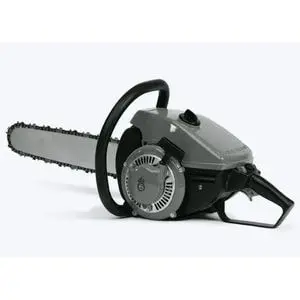 STIHL is a German manufacturer founded in 1926, and for many people the brand is almost synonymous with chainsaws. Its reputation has been built on robust, long-lasting tools operated by everyone from professional forestry teams to occasional domestic users.
STIHL is a German manufacturer founded in 1926, and for many people the brand is almost synonymous with chainsaws. Its reputation has been built on robust, long-lasting tools operated by everyone from professional forestry teams to occasional domestic users.
Husqvarna has an even longer history, with roots in Sweden going back to the 17th century. Today, the Husqvarna brand covers a wide range of outdoor power equipment, with chainsaws at the heart of its range.
Both brands have their own clear identities and engineering philosophies, but what they have in common is a strong focus on professional users, a deep product range, and a long track record of building dependable tools.
STIHL vs Husqvarna Chainsaws in Use
In terms of how the two companies’ saws handle when working through timber, broadly speaking:
Cutting Performance
 STIHL chainsaws are known for strong low-end torque. In simple terms, they have plenty of ‘grunt’ when you lean on them to make tougher cuts. They also have an excellent reputation for reliability.
STIHL chainsaws are known for strong low-end torque. In simple terms, they have plenty of ‘grunt’ when you lean on them to make tougher cuts. They also have an excellent reputation for reliability.
Husqvarna is usually associated with high chain speeds, smooth mid-range power delivery, and in petrol models both fuel efficiency and low emissions.
If you line up a Husqvarna chainsaw vs STIHL chainsaw of similar size, the STIHL often feels slightly more muscular at low revs, while the Husqvarna may feel a bit quicker and more free-revving. That difference is subtle on smaller saws, but becomes more apparent as you move into mid-size and professional models.
Comfort and Vibration
Ergonomically, Husqvarna is often praised for its vibration damping and overall comfort, especially during longer cutting sessions. STIHL, by contrast, has a reputation for solid, durable build quality and a slightly more ‘traditional’, weighty feel in the hands. Neither approach is right or wrong; it’s about which you personally prefer.
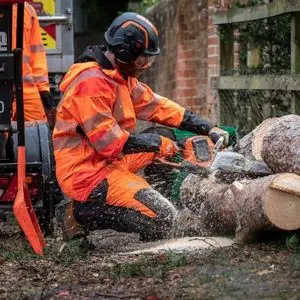 Value and Pricing
Value and Pricing
In many like-for-like comparisons, STIHL chainsaws can work out a touch more expensive. However, over the life of the saw, it’s a very fine margin because your sharpening, servicing, and fuel or battery costs will matter just as much as the initial outlay.
Dealer and Parts Support
Husqvarna and STIHL only use fully trained authorised dealers to sell their chainsaws, and we are proud to be an authorised dealer for both. Spare parts are readily available for each company’s chainsaws, including filters, chains, and guide bars. Indeed, some Husqvarna spare parts are made in the UK. If you need spare parts for a STIHL or Husqvarna chainsaw, be sure to use our Spare Parts Finder.
Husqvarna vs STIHL Product Matchups
To delve a little deeper into the Husqvarna vs STIHL debate, let’s compare a few like-for-like chainsaws…
Case Study 1: Compact Cordless Chainsaws
The first battery chainsaw STIHL vs Husqvarna comparison is at the smaller end of the size scale:
Both are designed for domestic users who want a light, quiet saw for general garden work.
 What They’re Designed For
What They’re Designed For
The MSA 60 C-B is positioned as a compact all-rounder for the garden: tidying up fallen branches, logging smaller pieces for the wood burner, and light pruning. It’s well balanced and robust for its size, and runs on STIHL’s AK battery platform, so owners can share batteries with other tools in the same system.
The Husqvarna 225i is aimed at similar tasks: pruning small trees, cutting occasional firewood, and general yard maintenance. It runs on Husqvarna’s interchangeable 36 V BLi-X batteries, which are also used across a wide variety of cordless machines, including hedge trimmers and mowers.
Key Differences in Use
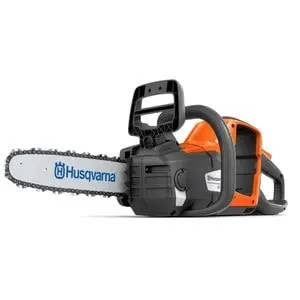 For lighter garden jobs, you’d struggle to say that Husqvarna chainsaws are better than STIHL, or vice versa, at this size. Both models are:
For lighter garden jobs, you’d struggle to say that Husqvarna chainsaws are better than STIHL, or vice versa, at this size. Both models are:
- Easy to handle
- Quiet compared with petrol
- More than capable of typical homeowner tasks
The 225i backs up its design brief with a quoted output of 0.8 kW and a chain speed of 11.8 m/s on a 30 cm (12-inch) bar, while the STIHL model focuses on being a sturdy, confidence-inspiring tool with the same bar size.
In terms of choosing one over the other, most people are simply guided by which company’s battery ecosystem is already in their tool shed. If you own STIHL cordless kit, the MSA 60 C-B is the natural choice. Likewise, if you’re invested in, or plan to build, a Husqvarna 36 V collection, the 225i will integrate neatly.
So, for many domestic users, the Husqvarna v STIHL chainsaw debate at this level is less about raw performance and more about which brand’s cordless system they tend to favour (both of which are superb).
Case Study 2: Mid-Size Cordless
Step up a level and the Husqvarna vs STIHL chainsaw comparison becomes more serious. Our mid-size cordless case study looks at the following tools:
 These models are aimed at demanding domestic, estate, and light professional use where cordless performance truly has to replace a mid-range petrol saw.
These models are aimed at demanding domestic, estate, and light professional use where cordless performance truly has to replace a mid-range petrol saw.
Intended Workload
The MSA 220 C-B is a powerful cordless saw capable of felling, logging, and construction work in timber. It typically uses a 35 cm (14-inch) bar, and is powered by STIHL’s professional-grade AP System batteries.
In performance terms, the Husqvarna 540i XP is positioned as the equivalent of a 40 cc professional petrol saw when paired with the recommended BLi300 battery. It is offered with bar options of 35 cm (14 inches) or 40 cm (16 inches) and is aimed at arborists, estate managers and other serious users.
Technology and Features
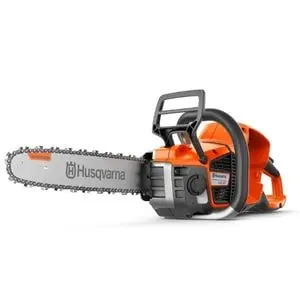 Here the distinction between the brands becomes clearer:
Here the distinction between the brands becomes clearer:
The STIHL MSA 220 C-B keeps things fairly straightforward. It includes tool-free chain tensioning, a clear oil tank, and sturdy metal bumper spikes that give the saw a familiar, no-nonsense feel.
The Husqvarna 540i XP leans into slightly more technology. Featuring weather-resistant electronics, choice of power modes, high chain speeds and optional connectivity functions, it is designed to appeal to professional users who work in all conditions.
So, is Husqvarna better than STIHL in this mid-size cordless segment? Not necessarily. Husqvarna’s 540i XP can be a superb choice if you want cutting-edge features and the very highest performance in a cordless format. The MSA 220 C-B, on the other hand, offers serious cutting ability with a slightly simpler, more familiar control layout, which many users prefer.
The honest answer is that the ‘better’ saw is the one whose ergonomics, battery system and price point fit your work pattern.
Case Study 3: Flagship Petrol Power
At the top of the two companies’ petrol ranges, sit the following saws:
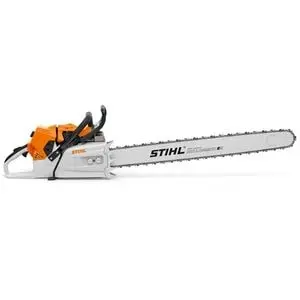 These machines show how each brand approaches ‘ultimate’ performance.
These machines show how each brand approaches ‘ultimate’ performance.
The MS 881 is widely regarded as the most powerful production chainsaw on the market, with a 121.6 cc engine, 6.4 kW (8.6 hp) output and bar options up to 105 cm (41 inches). It is built for the biggest timber and industrial forestry work.
The 592 XP features a 93 cc engine and 5.6 kW (7.5 hp) of output. It can run long bars up to around 70 cm (28 inches), and is squarely aimed at professional forestry and tree-care crews.
In other words, these are not saws for the average homeowner. The key difference is emphasis:
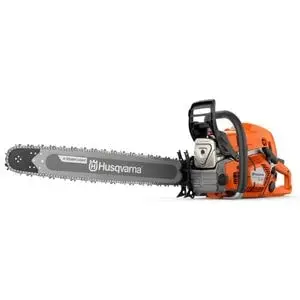 The STIHL MS 881 delivers all-out power and huge bar capacity, at the cost of higher weight and running demands.
The STIHL MS 881 delivers all-out power and huge bar capacity, at the cost of higher weight and running demands.
Husqvarna’s 592 XP is still extremely powerful, but a touch lighter and arguably more balanced for day-to-day work.
If you compare a Husqvarna versus STIHL chainsaw at this level, STIHL has the edge in outright muscle, while Husqvarna focuses on a blend of performance and manageability. Are STIHL chainsaws better than Husqvarna at the top-end of the petrol market? That depends on whether you value sheer power above all else, or prefer a slightly more pragmatic top-end machine.
And the Overall Winner Is…
So, is STIHL better than Husqvarna for chainsaws? (And in the interests of impartiality, we should also word the question, are Husqvarna chainsaws better than STIHL?) Well, while this topic certainly inspires passionate debate, in reality the choice comes down to what you need your saw to do.
 As a simple guide:
As a simple guide:
Occasional domestic users may lean towards STIHL for their chainsaws’ relatively simple, traditional design.
Regular users, landowners and semi-professionals might find Husqvarna’s emphasis on ergonomics and technology very appealing, especially in the cordless and mid-size petrol ranges.
Full-time professionals can happily work with either brand; at that level, comfort, performance, and service support tend to matter most, and here each brand excels.
Overall, are Husqvarna and STIHL the same level in terms of quality? Although each brand has its own unique selling points—yes, we believe they are.
Two Premium Brands, One Expert Destination
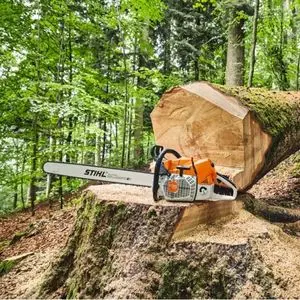 In the end, the Husqvarna v STIHL chainsaw debate can’t really have a single winner. Both manufacturers build premium tools that deliver outstanding performance, enjoy long service lives, and have very high levels of customer satisfaction. What more could any chainsaw owner desire?
In the end, the Husqvarna v STIHL chainsaw debate can’t really have a single winner. Both manufacturers build premium tools that deliver outstanding performance, enjoy long service lives, and have very high levels of customer satisfaction. What more could any chainsaw owner desire?
As an Authorised Dealer for both STIHL and Husqvarna, we are uniquely positioned to offer you an unrivalled selection of each company’s chainsaws. You can find Husqvarna’s complete collection of chainsaws here, and STIHL’s full range of chainsaws here.
What’s more, our expert team have in-depth product knowledge spanning both brands. Why not get in touch with us now to discuss your options and find the ideal saw for your needs? Let’s move beyond the old Husqvarna versus STIHL chainsaw debate and celebrate both companies for what they are—the world’s leading names in chainsaws.




